Sanyo FW65R79FC, FW55R79FC, FW50R79FC User Manual
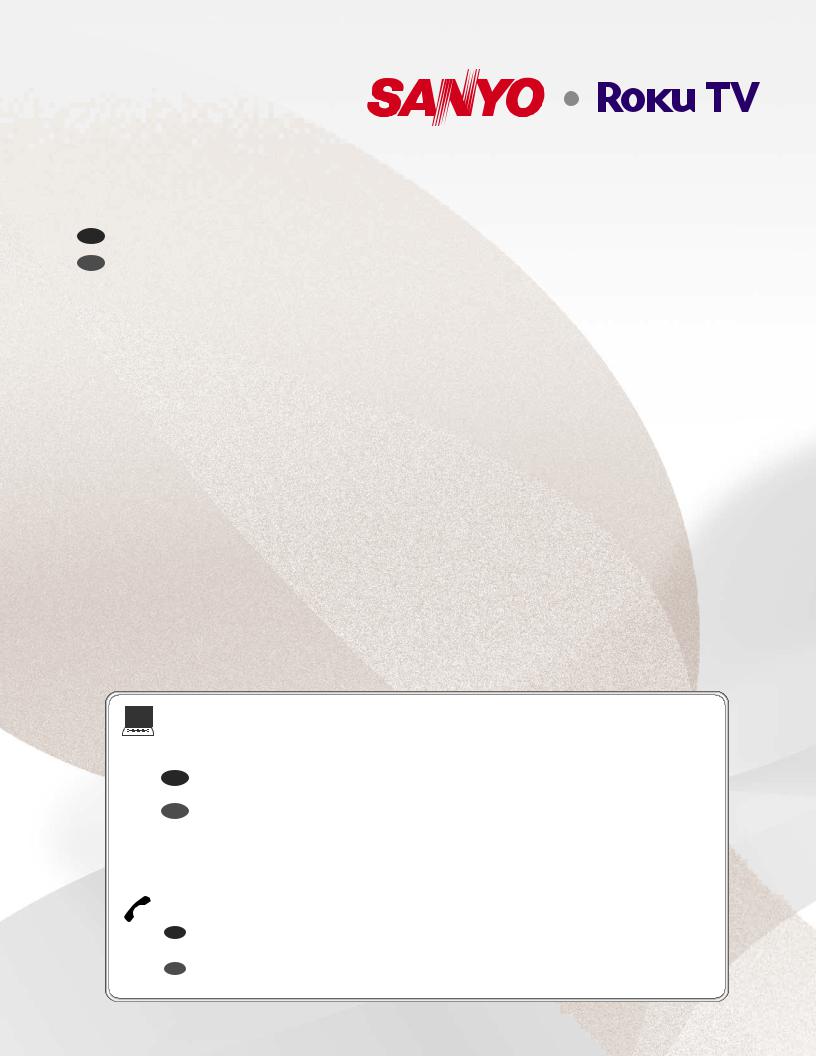
LCD TV
(LED BACKLIGHT)
Owner's manual
ES Manual del propietario
FR Manuel du propriétaire
FW65R79FC
FW55R79FC
FW50R79FC
To obtain a more detailed electronic copy of this manual or much further contents, go to
ES Para obtener una copia electronica detallada de este manual o mucho mayor contenido, visite
FR Pour obtenir une copie electronique plus detaillee de ce manuel ou pour aller encore plus loin, visitez
www.sanyo-av.com
Need help? Please call toll free 1 866 212 0436 or visit our web site above:
ES |
¿Necesita ayuda? Llame por favor sin costo al 1 866 212 0436 ó visite nuestro |
|
sitio web en: |
FR |
Besoin d’aide? Appelez notre numéro gratuit à 1 866 212 0436 ou visitez notre |
|
site web à l’adresse: |

Contents
|
1 |
Notice |
6 |
|
|
|
|
|
2 |
Welcome |
9 |
|
|
A new standard in Smart TVs |
9 |
|
|
Get the most out of your new TV |
9 |
|
|
|
|
|
3 |
Connections and setup |
11 |
|
|
Connecting an antenna, cable, or satellite box |
11 |
|
|
Connecting external equipment with a composite AV |
11 |
|
|
video cable |
|
|
|
Connecting external equipment with an HDMI® cable |
11 |
|
|
Connecting headphones or analog sound bar to the TV |
11 |
|
|
Connecting headphones to the Roku Enhanced Voice |
11 |
|
|
Remote |
|
|
|
Connecting an AV receiver or digital sound bar |
11 |
|
|
Preparing for Internet connectivity |
12 |
|
|
AC power |
12 |
|
|
Roku remote batteries |
12 |
|
|
Roku TV Remote |
13 |
|
|
Panel buttons |
14 |
|
|
Single button |
14 |
|
|
Three buttons |
14 |
|
|
Game-pad style joystick |
15 |
|
|
Four buttons |
15 |
|
|
Five buttons (with mute) |
15 |
|
|
Five buttons (without mute) |
15 |
|
|
Seven buttons |
15 |
|
|
|
|
|
4 |
Guided Setup |
16 |
|
|
Starting Guided Setup |
16 |
|
|
Completing Guided Setup |
16 |
|
|
Network connection |
17 |
|
|
Activation |
18 |
|
|
Connect your devices |
19 |
|
|
Home screen |
19 |
|
|
Personalize your Home screen |
20 |
|
|
|
|
|
5 |
Benefits of connecting |
21 |
|
|
Connecting brings out your TV’s full potential! |
21 |
|
|
What is streaming? |
22 |
|
|
What if I didn’t connect my TV? |
22 |
|
|
|
|
|
6 Setting up Antenna TV |
23 |
|
|
|
Why do I have to set up the TV tuner? |
23 |
|
|
How do I set up the TV tuner? |
23 |
2 .English
7 Using your TV |
25 |
Status indicator |
25 |
Standby mode energy savings |
25 |
Opting in to Smart TV experience (U.S. only) |
25 |
Disable Smart TV experience |
25 |
Disable Auto Notifications |
26 |
Watching Antenna TV channels |
26 |
Changing channels |
26 |
Favorite Channels in non-connected mode |
26 |
Smart Guide (U.S. only) |
27 |
Navigating the Smart Guide |
28 |
Favorite channels in the Smart Guide |
28 |
Turn off favorite channels |
28 |
Viewing program information |
28 |
Adjusting settings while watching a show |
29 |
Pausing Live TV |
29 |
Requirements |
29 |
Enabling Live TV Pause |
29 |
Using Live TV Pause |
29 |
Notes about Live TV Pause |
30 |
More Ways to Watch (U.S. only) |
30 |
Using More Ways to Watch |
30 |
Getting the most from More Ways to Watch |
31 |
Switching TV inputs |
32 |
Auto-detecting devices |
32 |
Adjusting audio/video settings |
32 |
Playing content from USB storage devices |
32 |
Auto player launch |
32 |
Playing content from local network media servers |
32 |
Using your TV in a dorm room |
33 |
About using your TV on a restricted public network |
33 |
Roku voice remotes (select models only) |
34 |
Re-pairing your Roku voice remote |
34 |
Checking the Roku voice remote battery level |
34 |
Finding your Roku Enhanced Voice Remote |
34 |
Changing and previewing the Enhanced Voice Remote |
34 |
finder sound |
|
8 |
Adjusting TV settings |
35 |
|
|
Settings menu |
35 |
|
|
Options menu |
35 |
|
|
Options menu settings |
35 |
|
|
Accessibility (U.S. only) |
36 |
|
|
Accessibility menu settings |
36 |
|
|
Video description through Secondary Audio Program |
36 |
|
|
(SAP) |
|
|
|
Advanced audio settings – Sonic Emotion Premium |
37 |
|
|
Advanced audio settings menu options – Sonic Emotion |
37 |
|
|
Premium |
|
|
|
Sonic Emotion settings |
37 |
|
|
Advanced picture settings |
37 |
|
|
Advanced picture settings menu options |
38 |
|
|
Expert Picture Settings (4K models only) |
38 |
|
|
Changing privacy settings |
39 |
|
|
Advertising |
39 |
|
|
Microphone |
39 |
|
|
|
|
|
9 |
My Feed |
40 |
|
|
Movies Coming Soon |
40 |
|
|
Movies, TV shows, and people |
40 |
|
|
|
|
|
10 Searching for something to watch |
41 |
|
|
|
How do I search? |
41 |
|
|
Keyboard search using the remote |
41 |
|
|
Voice Search from a Roku voice remote |
41 |
|
|
Searching from the Roku mobile app |
41 |
|
|
I found a show, now what? |
42 |
|
|
Follow on Roku |
42 |
|
|
Recent Searches |
42 |
|
|
|
|
|
11 Using the Roku Channel Store |
43 |
|
|
|
|
|
|
12 Customizing your TV |
44 |
|
|
|
Add TV inputs |
44 |
|
|
Add streaming channels |
44 |
|
|
Rename inputs |
44 |
|
|
Remove unwanted tiles |
44 |
|
|
Rearrange tiles |
44 |
|
|
Change themes |
45 |
|
|
Edit Antenna TV channel lineup |
45 |
|
|
Change volume |
46 |
|
|
Configure power settings |
46 |
|
|
Power on settings |
46 |
|
|
Auto power savings |
46 |
|
|
Standby LED On/Off |
46 |
|
|
Fast TV start |
46 |
|
3 |
|
|
.English |
Configure accessibility (U.S. only) |
47 |
|||
Captions mode |
47 |
|||
Captions preferred language |
47 |
|||
Captions style |
47 |
|||
Changing caption settings (Canada only) |
48 |
|||
Configuring parental controls |
48 |
|||
Creating a parental control PIN |
48 |
|||
Blocking Featured Free or Movie Store and TV Store |
49 |
|||
(U.S. only) |
||||
Blocking Broadcast TV shows |
49 |
|||
What happens when a TV show is blocked? |
51 |
|||
Changing the parental control PIN |
51 |
|||
Resetting parental controls |
51 |
|||
|
13 More settings |
52 |
|
Changing network settings |
52 |
|
Changing ZIP Code |
52 |
|
Changing time settings |
52 |
|
Scanning for Antenna TV channels again |
53 |
|
Setting the HDMI® mode (4K models only) |
53 |
|
Adjusting external device connections |
53 |
|
Using Roku Wireless Speakers |
53 |
|
Using the TV in a home theater |
54 |
|
Turning off the TV speakers for home theater use |
54 |
|
Setting up a digital audio connection |
54 |
|
Pairing Bluetooth devices with Roku Wireless Speakers |
54 |
|
Turning off the TV screen while listening to music |
54 |
|
Controlling other devices through CEC |
55 |
|
Restarting the TV |
55 |
|
Resetting the TV |
56 |
|
Reset audio/video settings |
56 |
|
Factory reset everything |
56 |
|
What if I can’t access the Factory Reset option? |
56 |
|
Network connection reset |
56 |
|
Changing your Roku Channel Store PIN preference |
56 |
|
Getting system updates |
57 |
|
Checking for updates on a connected TV |
57 |
|
Getting updates on a non-connected TV |
57 |
|
|
|
|
14 Other devices |
59 |
|
Screen Mirroring your phone or tablet |
59 |
|
Getting and using the Roku mobile app |
59 |
|
Private Listening on the Roku mobile app |
59 |
|
Using a universal remote |
59 |
|
|
|
|
15 FAQ |
60 |
|
|
|
16 Warranty |
64 |
|
●Due to software updates, this unit may operate differently from descriptions in this Use manual.
●For the latest ROKU TV user guide information, see the contents at the following URL. go.roku.com/tvmanual
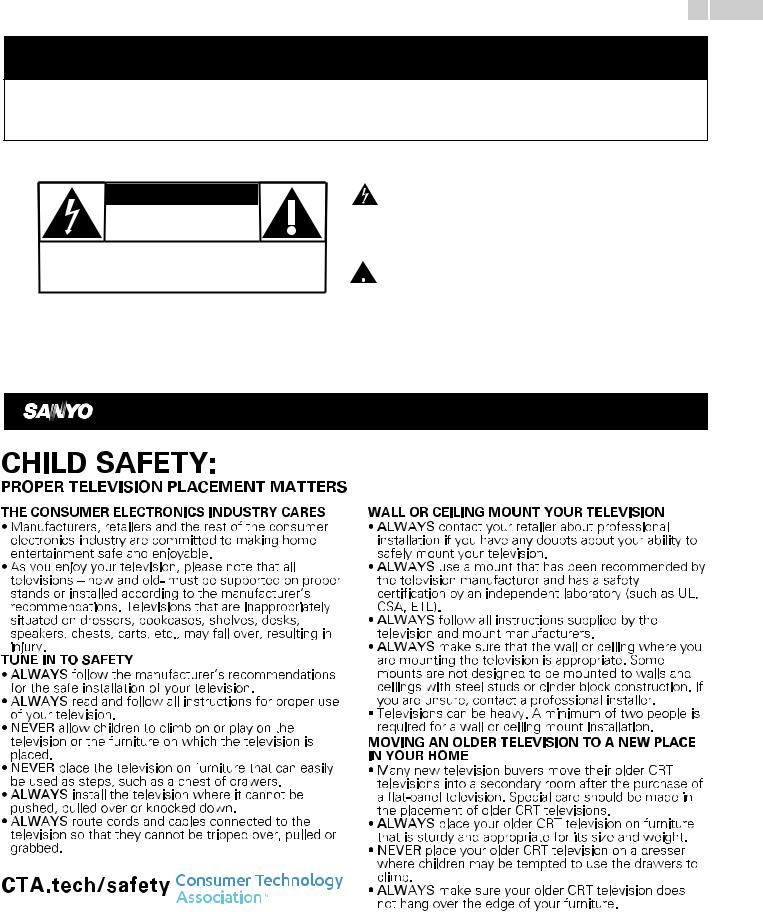
4 .English
Register online today at www.sanyo-av.com today to get the most benefits from your purchase.
Registering your model with SANYO makes you eligible for all of the valuable benefits such as software
upgrades and important product notifications.
Register online at www.sanyo-av.com
Know these safety symbols
CAUTION
RISK OF ELECTRIC SHOCK
DO NOT OPEN
CAUTION: TO REDUCE THE RISK OF ELECTRIC SHOCK, DO NOT
REMOVE COVER (OR BACK). NO USER-SERVICEABLE PARTS ARE
INSIDE. REFER SERVICING TO QUALIFIED SERVICE PERSONNEL.
The caution marking is located on the rear or bottom of the cabinet.
The lightning flash with arrowhead symbol, within an equilateral triangle, is intended to alert the user to the presence of uninsulated “dangerous voltage” within the apparatus’s enclosure that may be of sufficient magnitude to constitute a risk of electric shock to persons.
The exclamation point within an equilateral triangle is intended to alert the user to the presence of important operating and maintenance (servicing) instructions in the literature accompanying the apparatus.
WARNING: To reduce the risk of fire or electric shock, do not expose this apparatus to rain or moisture. Apparatus shall not be exposed to dripping or splashing and no objects filled with liquids, such as vases, shall be placed on the apparatus.
CAUTION: To prevent electric shock, match wide blade of plug to wide slot, fully insert.
Visit our World Wide Web Site at www.sanyo-av.com
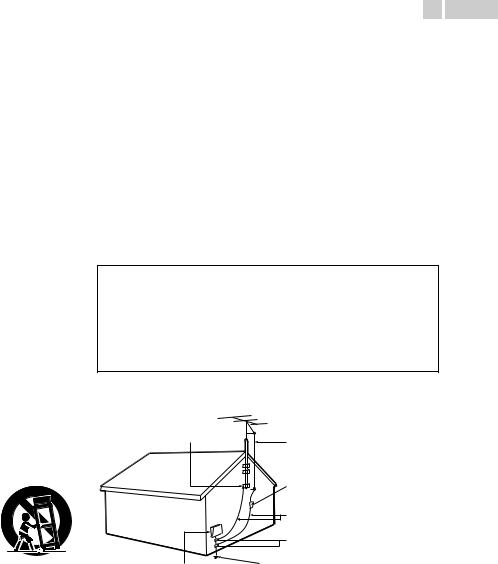
5 .English
Important safety instructions
1.Read these instructions.
2.Keep these instructions.
3.Heed all warnings.
4.Follow all instructions.
5.Do not use this apparatus near water.
6.Clean only with dry cloth.
7.Do not block any ventilation openings. Install in accordance with the manufacturer’s instructions.
8.Do not install near any heat sources such as radiators, heat registers, stoves, or other apparatus (including amplifiers) that produce heat.
9.Do not defeat the safety purpose of the polarized or grounding-type plug. A polarized plug has two blades with one wider than the other. A grounding type plug has two blades and a third grounding prong. The wide blade or the third prong are provided for your safety. If the provided plug does not fit into your outlet, consult an electrician for replacement of the obsolete outlet.
10.Protect the power cord from being walked on or pinched particularly at plugs, convenience receptacles, and the point where they exit from the apparatus.
11.Only use attachments / accessories specified by the manufacturer.
12.Use only with the cart, stand, tripod,
bracket, or table specified by the manufacturer, or sold with the apparatus. When a cart is used, use caution when moving the cart / apparatus combination to avoid injury from tip-over.
13.Unplug this apparatus during lightning storms or when unused for long periods of time.
14.Refer all servicing to qualified service personnel. Servicing is required when the apparatus has been damaged in any way, such as power-supply cord or plug is damaged, liquid has been spilled or objects have fallen into the apparatus, the apparatus has been exposed to rain or moisture, does not operate normally, or has been dropped.
Note to the CATV system installer:
This reminder is provided to call the CATV system installer’s attention to Article 820-40 of the NEC that provides guidelines for proper grounding and, in particular, specifies that the cable ground shall be connected to the grounding system of the building, as close to the point of cable entry as practical.
Example of antenna grounding as per NEC - National Electric Code
GROUND CLAMP |
ANTENNA LEAD IN WIRE |
|
|
||
|
ANTENNA DISCHARGE UNIT |
|
|
(NEC SECTION 810-20) |
|
|
GROUNDING CONDUCTORS |
|
|
(NEC SECTION 810-21) |
|
|
GROUND CLAMPS |
|
ELECTRIC SERVICE EQUIPMENT |
POWER SERVICE GROUNDING |
|
ELECTRODE SYSTEM (NEC ART 250, |
||
|
||
|
PART H) |
|
Wall mount bracket kit |
|
|
Funai is not liable for these types of accidents or injuries noted |
|||||||
|
|
|
|
Brand |
Model # |
Screw dimension |
below. |
|
|
||
|
|
|
|
● |
Install the wall mount bracket on a sturdy vertical wall. |
||||||
|
|
|
|
|
|
|
|
||||
|
|
FW65R79FC |
|
|
|
|
M6 x 0.472” (12mm) |
● |
If installed onto a ceiling or slanted wall, the TV and wall mount |
||
|
|
FW55R79FC |
|
SANUS |
|
F80b |
M6 x 1.378” (35mm) |
|
bracket may fall which could result in a severe injury. |
||
|
|
FW50R79FC |
|
|
|
|
● |
Do not use screws that are longer or shorter than their specified |
|||
|
|
|
|
|
|
|
|
length. If screws too long are used this may cause mechanical or |
|||
|
|
|
|
|
|
|
|
|
|||
|
|
|
|
|
|
|
|
|
|||
|
● |
Your TV meets the VESA standard for wall mounting. Consult with |
|
electrical damage inside the TV set. If screws too short are used |
|||||||
|
|
your local dealer for a wall mount bracket which is compatible with |
|
this may cause the TV set to fall. |
|||||||
|
|
your TV model. |
|
|
|
|
● |
Do not fasten the screws by excessive force. This may damage |
|||
|
● |
The recommended wall mount bracket kit (sold separately) allows |
|
the product or cause the product to fall, leading to an injury. |
|||||||
|
|
the mounting of the TV on the wall. |
|
● |
For safety reasons use 2 people to mount the TV onto a wall |
||||||
|
● |
For detailed information on installing the wall mount, refer to the |
|
mounting bracket. |
|
|
|||||
|
|
wall mount Instruction book. |
|
|
● |
Do not mount the TV onto the wall mounting bracket while your |
|||||
|
● |
Funai is not responsible for any damage to the product or injury |
|
TV is plugged in or turned on. It may result in an electrical shock |
|||||||
|
|
to yourself or others if you elect to install the TV wall mount |
|
injury. |
|
|
|||||
|
|
bracket or mount the TV onto the bracket. |
When installing the unit on the wall, allow this much |
||||||||
|
● |
The wall mount bracket must be installed by experts. |
space. |
|
|
||||||
|
|
|
|
|
|
|
|
Top |
: |
11.8 inches (30cm) |
|
|
|
|
|
|
|
|
|
Left and right side |
: |
5.9 inches (15cm) |
|
|
|
|
|
|
|
|
|
Bottom |
: |
3.9 inches (10cm) |
|
|
|
|
|
|
|
|
|
|
|
|
|

1 Notice
SANYO is a registered trademark of SANYO Electric Co., Ltd. and is used by Funai Electric Co., Ltd. and Funai Corporation, Inc. under license from SANYO Electric Co., Ltd.
Any liability related to SANYO products, including design and quality, is the sole responsibility of Funai Electric Co., Ltd. and Funai Corporation, Inc.
Please contact Funai Corporation, Inc. for any questions or claims related to SANYO products: www.sanyo-av.com
Funai reserves the right to change products at any time without being obliged to adjust earlier supplies accordingly.
The material in this Owner’s manual is believed adequate for the intended use of the system. If the product or its individual modules or procedures are used for purposes other than those specified herein, confirmation of their validity and suitability must be obtained. Funai warrants that the material itself does not infringe any United States patents. No further warranty is expressed or implied.
Funai cannot be held responsible neither for any errors in the content of this document nor for any problems as a result of the content in this document. Errors reported to Funai will be adapted and published on the Funai support website as soon as possible.
Pixel characteristics
This LCD product has a high number of color pixels. Although it has effective pixels of 99.999% or more, black dots or bright points of light (red, green or blue) may appear constantly on the screen. This is a structural property of the display (within common industry standards) and is not a malfunction.
Warranty
No components are user serviceable. Do not open or remove covers to the inside of the product. Repairs may only be done by service centers and official repair shops. Failure to do so shall void any warranty, stated or implied.
Any operation expressly prohibited in this Owner’s manual, any adjustments or assembly procedures not recommended or authorized in this Owner’s manual shall void the warranty.
Federal communications commission notice
This equipment has been tested and found to comply with the limits for a Class B digital device, pursuant to part 15 of the FCC Rules. These limits are designed to provide reasonable protection against harmful interference in a residential installation. This equipment generates, uses and can radiate radio frequency energy and, if not installed and used in accordance with the instructions, may cause harmful interference to radio communications. However, there is no guarantee that interference will not occur in a particular installation. If this equipment does cause harmful interference to radio or television reception, which can be determined by turning the equipment off and on, the user is encouraged to try to correct the interference by one or more of the following measures:
●Reorient or relocate the receiving antenna.
●Increase the separation between the equipment and the receiver.
●Connect the equipment into an outlet on a circuit different from that to which the receiver is connected.
●Consult the dealer or an experienced radio or television technician for help.
Declaration of conformity
Trade name |
: SANYO |
Responsible party |
: FUNAI CORPORATION, Inc. |
Model |
: FW65R79FC, FW55R79FC, FW50R79FC |
Address |
: 21061 S. Western Ave. Suite 210, |
|
Torrance, CA 90501, USA* |
Telephone number |
: 1 866 212 0436 |
*This is not the mailing address for Open Source Software or Customer service.
6 .English
Modifications
This apparatus may generate or use radio frequency energy. Changes or modifications to this apparatus may cause harmful interference.
Any modifications to the apparatus must be approved by Funai.
The user could lose the authority to operate this apparatus if an unauthorized change or modification is made.
Cables
Connections to this device must be made with shielded cables with metallic RFI / EMI connector hoods to maintain compliance with FCC Rules and regulations.
Canadian notice
CAN ICES-3 (B) / NMB-3 (B)
Analog and digital television receiving apparatus, Canada BETS-7 / NTMR-7.
The following FCC/IC RSS applies to the wireless LAN adapter included in this product.
FCC caution: Any changes or modifications not expressly approved by the party responsible for compliance could void the user’s authority to operate this equipment.
This transmitter must not be co-located or operated in conjunction with any other antenna or transmitter.
FCC/IC RF Exposure Compliance
This equipment complies with FCC/IC radiation exposure limits set forth for an uncontrolled environment and meets the FCC radio frequency (RF) Exposure Guidelines and RSS-102 of the IC radio frequency (RF) Exposure rules.
This equipment should be installed and operated keeping the radiator at least 20cm or more away from your body.
This device complies with Part 15 of FCC Rules and Industry Canada licence-exempt RSS standard(s). Operation is subject to the following two conditions: (1) this device may not cause interference, and (2) this device must accept any interference, including interference that may cause undesired operation of this device.
5150-5250 MHz band is restricted to indoor operations only.
High-power radars are allocated as primary users (i.e. priority users) of the bands 5250-5350 MHz and 5650-5850 MHz and that these radars could cause interference and/or damage to LE-LAN devices.
Compliance with IC requirement RSS-210 A9.4.4
Data transmission is always initiated by software, which is the passed down through the MAC, through the digital and analog baseband, and finally to the RF chip. Several special packets are initiated by the MAC. These are the only ways the digital baseband portion will turn on the RF transmitter, which it then turns off at the end of the packet. Therefore, the transmitter will be on only while one of the aforementioned packets is being transmitted. In other words, this device automatically discontinue transmission in case of either absence of information to transmit or operational failure.
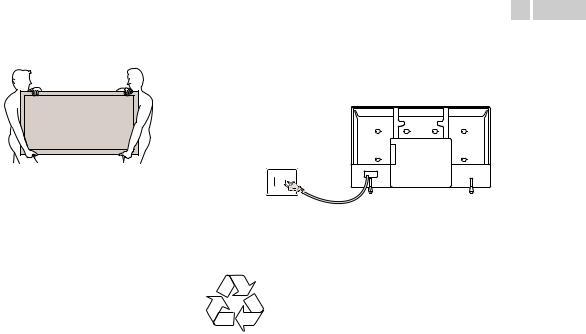
Positioning the TV
●Large screen TVs are heavy. 2 people are required to carry and handle a large screen TV.
● Make sure to hold the upper and bottom frames of the unit firmly as illustrated.
●Install the unit in a horizontal and stable position.
●Do not install the unit in direct
sunlight or in a place subject to dust or strong vibration.
●Depending on the environment, the temperature of this unit may increase slightly. This is not a malfunction.
●When installing this unit in a temperate environment, avoid a place with rapid temperature changes.
–Operating temperature: 41°F (5°C) to 104°F (40°C)
●This unit should not be used in a tropical environment as it has not been evaluated under such conditions.
●No objects should be placed directly on or under this unit, especially lighted candles or other flaming objects.
●Depending on your external devices, noise or disturbance of the picture and/or sound may be generated if the unit is placed too close to them. In this case, please ensure enough space between the external devices and the unit.
●Do not insert the AC power cord into the power socket outlet before all the connections are made.
●Ensure that you always have easy access to the AC power cord and outlet to disconnect the TV from the AC outlet.
●Before you move the TV, disconnect attached cables to prevent damage to connectors, especially the TV tuner.
●Be sure to unplug the AC power plug from the AC outlet before moving or carrying the unit.
●When moving the TV and then setting it down, please be careful not to pinch the AC power cord under the unit.
●Do not place this unit in an area where it may be exposed to water, oil or grease such as:
near a bathtub, basin, kitchen sink, washing tub, swimming pool, kitchen exhaust fan, etc., or in a damp basement.
Regulatory notices
WARNING : To prevent injury, this apparatus must be securely attached to the furniture / wall in accordance with the
instructions. Tipping, shaking or rocking the unit may cause injury / death.
WARNING : Never place a TV in an unstable location. A TV may fall, causing serious personal injury or death. Many injuries,
particularly to children, can be avoided by taking simple precautions such as:
–Using cabinets or stands recommended by the manufacturer of the TV.
–Only using furniture that can safely support the TV.
–Ensuring the TV is not overhanging the edge of the supporting furniture.
–Not placing the TV on tall furniture (for example, cupboards or bookcases) without anchoring both the furniture and the TV to a suitable support.
–Not placing the TV on cloth or other materials that may be located between the TV and supporting furniture.
–Educating the children about the dangers of climbing on furniture to reach the TV or its controls.
If your existing TV is being retained and relocated, the same considerations as above should be applied.
Do not place the unit on the furniture that is capable of being tilted by a child and an adult leaning, pulling, standing or climbing on it. A falling unit can cause serious injury or even death.
In order to avoid interruption of ventilation, this unit should not be placed in built-in equipment such as a book cabinet, rack, etc., and the vents of this unit should not be covered with anything such as a tablecloth, curtain, newspaper, etc. Make sure that there is enough ventilation space (4 inches / 10 cm or more) around this unit.
7 .English
Press B to turn the unit on and go into standby mode. To completely turn off the unit, you must unplug the AC power plug from the AC power outlet.
Disconnect the AC power plug to shut the unit off when trouble is found or not in use. The AC plug shall remain readily available.
AC power plug
Never use a gas duster on this TV.
The gas trapped inside of this unit may cause ignition and explosion.
Environmental care
The packaging of this product is intended to be recycled.
Contact your local authorities for information about how to recycle the packaging.
For product recycling information, please visit - www.sanyo-av.com
End of life directives
SANYO pays a lot of attention to produce environmental-friendly products in green focal areas. Your new TV contains materials which can be recycled and reused. At the end of its life, specialized companies can dismantle the discarded TV to concentrate the reusable materials and to minimize the amount of materials to be disposed of. Please ensure you dispose of your old TV according to local regulations.
# Batteries usage
CAUTION : Danger of explosion if battery is incorrectly replaced. Replace only with the same or equivalent type.
WARNING : Batteries (battery pack or battery installed) should not be exposed to excessive heat such as sunshine, fire or the
like.
●Do not mix old and new batteries.
●Do not mix alkaline, standard (carbon-zinc) or rechargeable (ni-cad, ni-mh, Li-ion, etc.) batteries.
Disposal of used batteries
The batteries included do not contain the heavy metals mercury and cadmium, however in certain localities, disposing batteries with household waste is not permitted. Please ensure you dispose of batteries according to local regulations.

Preparing to move / ship the unit
Please pack the unit properly by following the diagram on the carton (as noted below).
●To avoid damage to the screen, do not pack the stand on the same side as the TV screen, refer to the illustration above.
8 .English
Copyright
All other registered and unregistered trademarks are the property of their respective owners.
The terms HDMI and HDMI HighDefinition Multimedia Interface, and the HDMI Logo are trademarks or registered trademarks of HDMI Licensing Administrator, Inc. in the United States and other countries.
Manufactured under license from Dolby Laboratories. Dolby, Dolby Audio, and the double-D symbol are trademarks of Dolby Laboratories.
Portions of this software are copyright © The FreeType Project (www.freetype.org).
The American Academy of Pediatrics discourages television viewing for children younger than two years of age.
Some apps are not pre-installed, internet connection is required for download.
FUNAI CORPORATION, Inc. does not warrant access to the portal or to any of the services, content, software and advertising. FUNAI CORPORATION, Inc. or third party content / service providers may, in their sole discretion, add or remove access to any specific services, content, software and advertising at any time. Although FUNAI CORPORATION, Inc. will strive to provide a good selection of services, content or software, FUNAI CORPORATION, Inc. does not warrant continued access to any specific services, and content or software.
FUNAI CORPORATION, Inc. does not warrant wireless screencasting compatibility with all source devices such as smartphones, tablets, laptops, etc. due to large variability in hardware, firmware, drivers, software and implementation of wireless casting applications on these source devices. Although FUNAI CORPORATION, Inc. will strive to enhance compatibility and performance across a range of source devices, FUNAI CORPORATION, Inc. does not warrant compatibility with specific source devices.
© 2018 Funai Electric Co., Ltd. All rights reserved.
No part of this Owner’s manual may be reproduced, transmitted, disseminated or transcribed, in any form or for any purpose without the express prior written consent of Funai. Furthermore, any unauthorized commercial distribution of this Owner’s manual or any revision hereto is strictly prohibited.

2 Welcome
Congratulations on the purchase of your new Roku TV! Discover the joy of endless entertainment. After it’s set up, you’ll be able to access a world of streaming content channels that may include paid subscription channels like Netflix or free channels like YouTube, Crackle, CNET and literally thousands more.
Important : Your TV receives automatic updates from time to time, enabling new content and features. This edition of the User Guide describes Roku TV version 8.0. To determine the current version of your Roku TV, go to Settings > System > About after you complete Guided Setup.
A new standard in Smart TVs
Welcome to TV like you’ve most likely never seen before—a home screen that you can personalize with your favorite devices and streaming channels. Choose from hundreds of thousands of streaming movies and TV episodes, plus music, sports, kids, family, international and much more. You should never run out of things to watch.
 Note(s)
Note(s)
●A paid subscription or other payments may be required for some channel content. Channel availability is subject to change and varies by country.
Get the most out of your new TV
Follow these simple steps to get the most out of your new TV. 1 Connect to the Internet
●It’s simple, it’s easy, and it will unlock a world of entertainment. All you need is a network connection. There are hundreds of free streaming channels, paid subscription services like Netflix and Spotify, and convenient ways to rent or buy a favorite film or show with, for example, Google Play
2 Pick your favorite streaming channels
●Find the entertainment you love. From the latest blockbuster movies to your favorite TV shows, with tons of live sports, a broad selection of music streaming channels, popular programming in a dozen international languages, 24x7 live news and so much more, your new Roku TV has your sweet spot. A paid subscription or other payments may be required for some channels.
3 Find Antenna TV shows in the Smart Guide
●Only in the United States, use the Smart Guide to see not only what’s on TV right now, but what was on up to a week ago, and what will be on in the coming two weeks. And for many over-the-air programs, if you start watching the program after it is already in progress, or you see something you missed in the Smart Guide, you can use More Ways to Watch to find streaming channels where you can see the show from the beginning, find other episodes, or entire seasons of the show, if applicable.
4 Use Roku’s Smart TV experience to discover More Ways to Watch on other inputs
● Only in the United States, When watching programs from a cable box, Blu-ray player, or other source connected to the
HDMI® or AV inputs, keep an eye out for a notification of streaming channels that offer the program you’re currently watching and, if applicable, other episodes, the entire series, or other programs with similar themes.
9 .English
5 Personalize your Home screen
●Put your favorite streaming channels, and TV inputs front-and- center on the Home screen. No more flipping through inputs or wading through complicated menus. You can even customize the names of each input and move tiles around so your most-often used devices and streaming channels are only a click away.
6 Search for your favorite movie, TV show, actor, or director
●Once you’re connected to the internet, you can easily search across top streaming channels and Antenna TV channels. Search by movie or TV show title, actor or director—all from one place. Search by typing words or phrases using the onscreen keyboard or on your mobile device or, only in the United States, speak words or phrases in a conversational tone using Voice Search. Some channels and content require payment.
7 Pause live TV
●Pause, resume, fast forward, and rewind TV shows. Simply connect your own USB drive with 16GB or bigger capacity to the TV and pause live TV for up to 90 minutes.
 Note(s)
Note(s)
●Live TV Pause is available on digital TV shows received on the Antenna TV input, and only when the TV is linked to a valid Roku account.
8 Control your TV with voice commands
●Only in the United States, use your Roku Voice Remote (select models), Enhanced Voice Remote (select models), or the free Roku mobile app to control your Roku TV. Use conversational voice commands to search for programs by title, actor, director, or genre. Also use voice commands to launch streaming channels, switch inputs, change Antenna TV channels, or open the Smart Guide.
9 Send your personal media to the big screen
●Send personal photos, videos, and music from your compatible smartphone or tablet to the TV screen in just a few taps. Plus, with certain channels, such as Netflix and YouTube, you can send movies, shows, sport highlights, and more directly to your TV.
10 Follow movies coming soon
●Use My Feed to choose from and follow a list of upcoming movies, and then watch for alerts each time one of your followed movies becomes available or changes price.
11 Take charge with a smartphone or tablet
●Control your TV with the included remote or from your compatible smartphone or tablet with the free mobile app for iOS®, and Android™ mobile devices . Browse channels, view My Feed, listen to audio from Antenna TV and streaming channels. Search more easily using a your mobile device’s keyboard and, only in the United States, Voice Search.
●Mirror your compatible smartphone or tablet on your TV. Share videos, photos, web pages, and more from compatible devices.
12 Connectdorms. your Roku TV to networks found in hotels and college
●You can temporarily link the TV to your smartphone or table to agree to any terms, enter codes, or provide required information before you can get Internet access.

10 .English
 Note(s)
Note(s)
●Using your Roku TV on a restricted public network requires wireless availability and use of your network-connected smartphone, tablet, or computer to authenticate access to your account. You must use your Roku TV remote to initiate the connection process. Streaming content might be limited due to your geographic location or because of restrictions imposed by the network host.
Go to support.roku.com for device compatibility information.
Let’s get started.

3 Connections and setup
Refer to your TV’s Quick Start Guide or other provided documentation to for model-specific information about attaching the base or a wall mount and making connections to AC power and to your other audio/video devices. The following information applies to all Roku TV models.
Connecting an antenna, cable, or satellite box
If you are using an antenna, CATV cable without a set-top box, or a cable or satellite box that has only an antenna output, connect a 75ohm coaxial cable (not provided) from the device to the ANT/CABLE input on the TV.
 Tip(s)
Tip(s)
●If you are using an antenna with a 300 ohm twin-lead cable, you need to use a 300-to-75 ohm adapter (not provided) to adapt the twin-lead cable to a connection that is compatible with the TV’s antenna input.
●If you receive your TV stations through a set top box from a cable or satellite TV provider, connect it to the TV using the best connection method available. From most to least desirable:
–HDMI® input – Digital HD and SD video
–AV input – analog SD video
–Antenna input – analog SD video using NTSC
Connecting external equipment with a composite AV video cable
If the best connection available on your device is AV or composite video output, connect it to the TV using a composite AV cable (not provided). Composite AV cables typically have three RCA-type plugs on each end, color coded as follows:
–Yellow– Video
–Red– Audio, right channel
–White or black– Audio, left channel
Connect each plug to the corresponding connector on the device and on the TV.
 Note(s)
Note(s)
●Select models have an AV Input that looks like a headphone jack. Use the breakout cable (included) to adapt this input to the three RCA-type plugs on your composite cable.
Connecting external equipment with an HDMI® cable
If possible, connect your devices using HDMI® cables (not provided). They help to provide the best video quality and also carry audio signals, so that only one cable is needed. For better picture quality, we recommend that you use cables designated as High Speed HDMI® Cables.
 Tip(s)
Tip(s)
●You might need to configure the device to send its signal through its HDMI® connector
The connector labeled HDMI IN (ARC) has the additional ability to use the audio return channel to send digital audio to a receiver or sound bar, as explained in Connecting an AV receiver or digital
sound bar L p. 11
11 .English
Connecting headphones or analog sound bar to the TV
You can connect headphones or an analog sound bar (not provided) to the TV’s headphone jack.
 Tip(s)
Tip(s)
●Inserting a plug in the headphone jack disables the sound from the TV’s built-in speakers.
 Warning
Warning
Loud noise can damage your hearing. When using headphones, use the lowest volume setting on your headphones that still lets you hear the sound. Select models also have an audio line out connection that is not affected by TV volume or mute settings and does not disable the TV speakers. Use this connection when you want to use your amplifier or sound bar to control the TV volume. To turn off
the TV’s built-in speakers, in the Home screen menu, navigate to Settings > Audio > TV speakers and change the setting.
Connecting headphones to the Roku Enhanced Voice Remote
Select Roku TVs come with the Roku Enhanced Voice Remote. On these models, you can connect headphones to the jack on the left side of the remote.
 Tip(s)
Tip(s)
●Inserting a plug in the remote’s headphone jack disables the sound from the TV’s built-in speakers or attached receiver or sound bar. The volume and mute controls on the right side of the remote adjust the volume level of the connected headphones.
 Warning
Warning
Loud noise can damage your hearing. When using headphones, use the lowest volume setting on your headphones that still lets you hear the sound. You might notice that connecting headphones to your remote shortens the remote’s battery life somewhat.
Connecting an AV receiver or digital sound bar
You can enjoy Dolby Audio™ multichannel sound from your TV if you connect a digital amplifier or sound bar (not provided) in either of two ways:
●Digital optical audio out (S/PDIF) – Connect a TOSLINK optical cable (not provided) from the TV to the Optical input on your receiver or sound bar.
●HDMI® ARC – Connect an HDMI® cable (not provided) from the HDMI (ARC) connector to the HDMI® input on your
receiver or sound bar. This connection uses the Audio Return Channel (ARC) feature of the HDMI® specification to output sound from the TV to a compatible device. To use this feature, you must configure the TV to enable HDMI® ARC, as explained in Enable HDMI®ARC L p. 55.

12 .English
Preparing for Internet connectivity
If you want to watch streaming content and take advantage of the cool features of your Roku TV, connect it to the Internet through a wireless modem/router or a wireless access point (not provided). The TV has a built-in wireless LAN adapter (2.4GHz, 5GHz, IEEE 802.11 b/g/n/ac).
 Note(s)
Note(s)
●The TV supports only its internal wireless network adapter—it does not support the use of a USB network adapter.
Select 4K models have wired in addition to wireless network connectivity. To use the wired network connection, connect an RJ-45 Ethernet cable (not provided) from the jack on the back of your TV to your network router or switch. The wired connection supports both 10 Base-T and 100 Base-T Ethernet.
AC power
Plug your TV into a power outlet. You can tell that the TV has power because the status indicator lights up when the TV is off.
The topic Status indicator L p. 25 explains how the status indicator shows what is happening with the TV.
Roku remote batteries
Open the back of your Roku remote and insert the included batteries, observing the proper orientation as indicated in the battery compartment. Reattach the back cover.

Roku TV Remote
Use the following information to identify the buttons on your Roku remote.
 Note(s)
Note(s)
●Certain remote buttons and features vary by model. Your remote might not have all buttons or features listed.
●If your remote has a microphone button D just below the purple pad, then you have a Roku Voice Remote.
●If your remote has a headphone jack on its left edge, then you have a Roku Enhanced Voice Remote.
A
B
 C
C
D
F
E

 H
H
G
I
13 .English
A9(Power)
Turns TV on and off.
B7(Back)
●Menu: Goes back to previous menu/screen.
●Home screen tile: Moves highlight back to the Home screen option.
●Watching Antenna TV or a TV input: Returns to Home screen.
●Playing streaming content: Stops playing stream and returns to the previous menu or screen.
●Browsing streaming content: Goes to the previous level in the content tree.
C8(Home)
Immediately returns to the Home screen.
DPad
●Left / Right / Up / Down moves the highlight in the corresponding direction.
●OK selects the highlighted option.
While watching TV:
●Up/Down changes channel.
●Left displays the Smart Guide (connected mode) or channel list (non-connected mode).
●Left / Right only on TVs operating in non-connected mode, while in the channel list switches between All Channels and Favorite channels.
●OK while in the channel list selects the highlighted channel. While watching live TV, displays the program information banner.
EC(Instant replay)
Select models. Streaming programs that support this feature and Antenna TV channels: if Live TV Pause is enabled, jumps back a few seconds with each press and resumes playing.
Broadcast TV: if Live TV Pause is disabled, jumps to previous channel.
When using an on-screen keyboard: Backspaces in the text you are entering.
Smart Guide: Return to the current day and time.
FB(Sleep)
Select models. Displays a banner showing the remaining sleep time, if any, or Sleep timer is off. Subsequent presses cycle among the preset sleep time intervals. Once set, the sleep timer remains in effect regardless of what you are watching.
GMedia playback controls
Rewind, pause, play, and fast forward streaming content and Antenna TV channels (if Live TV Pause is enabled).
Press Rewind or Fast forwardone,two,orthreetimestocontrol the speed of the operation.
Rewind and Fast forward also jump backward and forward one page at a time when viewing long lists, such as when you are browsing Antenna TV shows in the channel list or Smart Guide (U.S. only).
HA(Options)
Displays additional options when available.
On-screen hints let you know when this button is active.
I4/5 (Volume) / 6(Mute)
Increases/decreases volume and mutes the TV sound.
 Note(s)
Note(s)
●If the TV is muted, pressing Volume up unmutes. Pressing Volume down does not unmute the sound.

Panel buttons
Your TV has a set of panel buttons that perform simple control functions. The TV panel buttons are not a substitute for the remote, as they do not give you access to all TV functions.
Depending on model, your TV model has one of several different panel button designs. Choose the one that applies to your TV from the following list:
–Single button
–Three buttons
–Game-pad style joystick
–Four buttons
–Five buttons (with mute)
–Five buttons (without mute)
–Seven buttons
Single button
If your TV has this style of panel button, you can perform the following functions:
–Turn TV on : short press
–Display the Input List : short press when TV is on
–Select the next input in the Input List : short press while the TV is showing the Input List
–Dismiss the Input List without changing inputs : no press
–Turn TV off : long press
Short press = less than two seconds
Long press = more than two seconds
No press: = no press within two seconds
14 .English
Three buttons
If your TV has this style of panel buttons, you can perform the following functions:
–Turn TV on : middle button, short or long press
–Volume up : right button when Input List is not active
–Volume down : left button when Input List is not active
–Display Input List : middle button, short press when TV is on
–Highlight next input in the Input List : right button when Input List is active
–Highlight previous input in the Input List : left button when Input List is active
–Select highlighted item in the Input List : middle button, short press, or no press
–Turn TV off : middle button, long press
Short press = less than two seconds
Long press = more than two seconds
No press: = no press within four seconds
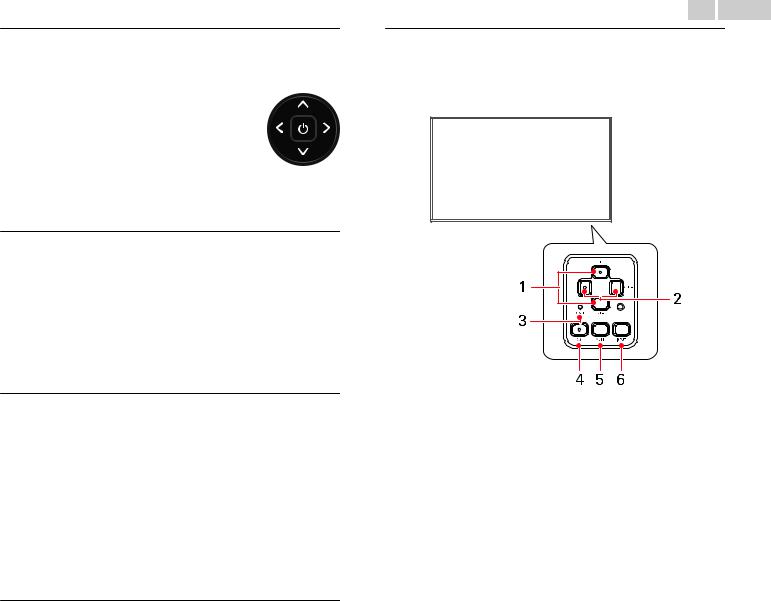
Game-pad style joystick
If your TV has this style of panel button, you can perform the following functions:
– Press in : Toggle between power ON and
Standby
– Press up or down : Increase/decrease the volume
– Press left or right : Switch inputs.
Each press moves the highlight up or down one item. Pausing for a few moments selects the highlighted item.
Four buttons
If your TV has this style of panel buttons, you can perform the following functions:
–Power: Turns the power on and off.
–Input: Selects among TV inputs. Each press moves down one item. Pausing for a few moments selects the highlighted item.
–Volume +: Increases the volume.
–Volume –: Decreases the volume.
Five buttons (with mute)
If your TV has this style of panel buttons, you can perform the following functions. Note that the order of the buttons might vary from model to model. Examine the panel button labels to determine your TV model’s layout.
–Power: Turns the power on and off.
–Input: Selects among TV inputs. Each press moves down one item. Pausing for a few moments selects the highlighted item.
–Volume +: Increases the volume.
–Volume –: Decreases the volume.
–Mute: Mutes and unmutes the sound.
Five buttons (without mute)
If your TV has this style of panel buttons, you can perform the following functions. Note that the order of the buttons might vary from model to model. Examine the panel button labels to determine your TV model’s layout.
–Power: Turns the power on and off.
–Input +: Selects the next TV input. Each press moves down one item. Pausing for a few moments selects the highlighted item.
–Input -: Selects the previous TV input. Each press moves up one item. Pausing for a few moments selects the highlighted item.
–Volume +: Increases the volume.
–Volume –: Decreases the volume.
15 .English
Seven buttons
If your TV has this style of panel buttons, you can perform the following functions. Note that the order of the buttons might vary from model to model. Examine the panel button labels to determine your TV model’s layout.
Control panel located on the back of the TV.
1.Channel +: Moves the highlighted item up in the current menu.
Channel –: Moves the highlighted item down in the current menu.
2.Volume +: Increases the volume. Volume –: Decreases the volume.
3. |
Reset: |
Press once to reset your TV* |
|
|
*All setting will be reset to its factory defaults. |
4. |
Power: |
Turns the power on and off. |
5. |
Mute: |
Mutes and unmutes the sound. |
6. |
Input: |
Selects among TV inputs. Each press moves down |
|
|
one item. Pressing Channel + or Channel – moves |
the highlight up or down. Pausing for a few moments selects the highlighted item.

4 Guided Setup
With the preliminaries out of the way, it’s time to turn on your TV. As the TV starts for the first time, it leads you through Guided Setup, which configures the TV before you start to use it.
–During Guided Setup, you’ll:
–Answer a few questions
–Provide network connection information
–Get a software update
–Link your TV to your Roku account.
–Connect devices such as a DVD player, game console, or cable box.
Starting Guided Setup
To start Guided Setup, press the 9 button on the remote to turn on your TV.
 Note(s)
Note(s)
●Guided Setup normally runs only once, the first time you turn on your TV. If you need to run Guided Setup again, you’ll have to perform a factory reset, as explained in Factory reset everything L p. 56.
When you first turn on your TV, it will take a few seconds to get itself ready. You’ll notice the following things happening:
1 |
The status indicator blinks every time the TV is busy doing |
|
something; in this case it’s powering up and getting ready for |
|
you. |
2 |
The power-on screen appears and the status indicator blinks |
|
slowly for a few more seconds. The power-on screen shows a |
|
brand logo while the TV starts up. |
3 |
After a few seconds, Guided Setup starts. |
Completing Guided Setup
Follow these steps to complete Guided Setup. At this point, you should be seeing the Language screen.
1 Only on models that have a Roku voice remote: A few moments after the Let’s get started screen appears, Guided Setup starts the pairing process for the voice remote. (You’ll know if you have this type of remote because it will have microphone or search button just below the down arrow on the purple pad.) If the voice remote does not pair automatically, follow the instructions on the screen to complete the pairing process.
16 .English
 Tip(s)
Tip(s)
●On TVs sold in the United States, if you are blind or visually impaired, you can activate Audio Guide, a text-to-speech screen reader to help you navigate the TV’s menus and commands. To
enable the Audio Guide, press the A button on the remote four times in rapid succession. Repeat to disable Audio Guide. (The A button is located directly below the directional pad on the right side of the Roku remote.)
 Note(s)
Note(s)
●If you enabled Audio Guide, choosing any language other than English disables it.
2 Press the Down arrow on the remote to highlight your preferred language, and then press OK or the Right arrow.
3 Some models have a country selection screen: If you don’t see this screen, skip ahead to the next step. If you see this screen, select your country.
 Note(s)
Note(s)
●If you enabled Audio Guide, choosing any country other than United States disables it.
4 Press OK or the Right arrow on the remote to go to the next screen:
 Note(s)
Note(s)
● Some models show the title First things first instead of Set up environment.

5 Press OK to select Set up for home use. This is the right choice for enjoying your TV at home. It provides energy saving options as well as access to all features of the TV.
 Note(s)
Note(s)
●Store mode configures the TV for retail display and is not recommended for any other use. In store mode, some features of the TV are missing or limited. To switch from one mode to the other, you have to perform a factory reset as explained in Factory reset everything L p. 56, and then repeat Guided Setup.
Network connection
After you select Set up for home use, the TV prompts you to make a network connection. If your TV has both wired and wireless connections, you’ll see the following screen.
6 Only models that display the Connect to the Internet screen: Make a selection:
–Wireless connection – Highlight Set up new wireless connection and press OK. The TV prompts you through wireless setup. Skip ahead to the next step for help with the process.
–Wired connection – Highlight Connect to wired network and press OK. The TV immediately attempts to connect to your wired network, your local network, and then the Internet. Go to Step 9 to continue with Guided Setup.
–Connect to the Internet later – If you don’t want to connect to the Internet right now, you can skip this step and use the TV to watch Antenna TV channels, play games, and watch DVDs. When you’re ready to connect, it’s easy. We’ll show you how in Benefits of connecting L p. 21
 Note(s)
Note(s)
●If you decide not to connect, Guided Setup skips ahead to setting up the devices that you’ve connected to your TV. Jump ahead to Connect your devices L p. 19 to complete Guided Setup.
17 .English
7 On models that have wireless only, or models with both wired and wireless and you’ve selected Wireless: The TV scans for the wireless networks within range and displays them in order, with the strongest signals first. In addition to your own wireless signal, the TV might pick up signals from your neighbors.
Press the Up or Down arrows to highlight the name of your wireless network, and then press OK to select it.
 Note(s)
Note(s)
●Some networks, such as those often found in dorm rooms, hotels, and other public places, require you to read and agree to terms, enter a code, or provide identifying information before letting you connect to the Internet. If your Roku TV detects that you are connecting to such a network, it prompts you through the connection process using your compatible smartphone or tablet to provide the needed information.
For more information, see Using your TV in a dorm room L p. 33.
Other options
●Connect to the Internet later – If you don’t want to connect to the Internet right now, you can skip this step and use the TV to watch Antenna TV channels, play games, and watch DVDs. When you’re ready to connect, it’s easy. We’ll show you how in Benefits of connecting L p. 21.
 Note(s)
Note(s)
●If you decide not to connect, Guided Setup skips ahead to setting up the devices that you’ve connected to your TV. Jump ahead to Connect your devices L p. 19 to continue.
●Scan again / Scan again to see all networks – The name of this option depends on the number of wireless networks within range.
–Scan again appears if the list already shows all available wireless networks within range. If you don’t see your wireless network name in the list, you might need to adjust the location of your wireless router or the TV, turn on your router, or make other changes. When everything is ready, select Scan againto see if your network name now appears in the list.
–Scan again to see all networks appears if there are more wireless networks than the strongest ones it initially listed. If you don’t see your wireless network name in the list, this option displays the complete list. If you still don’t see your network name, you might have your router configured to provide wireless service as a “private network.”
 Note(s)
Note(s)
●Highlighting either of these options displays an informational panel with the unique media access control (MAC) address of your Roku TV. You will need the MAC address if your wireless router is configured to use MAC address filtering.

●Private network – If your wireless network name is hidden, it won’t appear in the list. Select Private network to display an on-screen keyboard, and use it to enter your network name.
Unless you changed the factory-set network name, you can find the name (also called SSID) on a label on the router.
 Tip(s)
Tip(s)
●Wireless networks that are password-protected display a “padlock” icon adjacent to the name. This icon enables you to know that you are going to be prompted to enter a password after you select that network.
18 .English
As soon as the TV is able to connect to the Internet, it downloads and installs its first software update, and then restarts.
 Tip(s)
Tip(s)
● Your TV automatically checks for updates periodically.
These updates provide new features and improve your overall experience with the TV. After an update, you might notice that some Options have moved, and that there are new options or features. This User Guide describes version 8.0. To determine your current Roku TV software version, go to Settings > System > About after you complete Guided Setup. You can download an updated User Guide that matches your Roku TV software version from the Roku TV web site.
8 Only if you select a password protected wireless network: An on-screen keyboard appears. Use the keyboard to enter the network password.
After you submit your wireless network password, the TV displays progress messages as it connects to your wireless network, your local network, and the Internet.
9 Only if your TV cannot get the correct time zone and current time from your network service provider: Use the Up and Down arrows to highlight your time zone, and then press OK.
 Tip(s)
Tip(s)
●Your TV needs to know the local time zone so that it can correctly display information about the program you are currently watching. If the TV is unable to automatically determine the local time zone, it prompts you to choose your time zone from a list.
Activation
After the TV restarts, it displays the Activation screen:
10 Using a compatible computer, tablet, or smartphone with an Internet connection, go to the web address displayed on the screen and enter the code that appears on your screen.
 Note(s)
Note(s)
●Please enter the website address exactly as displayed. There is no charge for activation. If a website is indicating a charge, please check the address carefully and reenter.
Why do I need a Roku account?
You need a Roku account for several reasons:
●It links you, your Roku TV, and your other Roku streaming devices to the Roku Channel Store and billing service.
●Streaming content providers know that it’s OK to send content you request to your Roku TV.
●Roku can automatically send updates to your device.
You need a Roku account to activate your device and access entertainment across thousands of streaming channels. Roku accounts are free, and while a valid credit card number is not required to create your account, providing your credit card information makes renting and purchasing entertainment from the Roku Channel Store fast and convenient.
After you log in or create your Roku account, the link page suggests that you select some streaming channels. After you confirm your selections, the TV gets an acknowledgement, and then adds your preexisting and newly-selected streaming channels to your Roku TV. This process is automatic and takes a few moments—a little longer if you already have a lot of streaming channels to add.
 Tip(s)
Tip(s)
●Streaming channels from all Roku streaming devices associated with your account are synchronized periodically, so that all of your Roku streaming devices have the same set of streaming channels (subject to compatibility with the device).

Connect your devices
Next, Guided Setup helps you set up the external devices that you want to use with it, such as a cable box, Blu-ray™ player, or game console.
11 Press OK or the Right arrow to proceed:
12 Connect all the devices you plan to use with your TV, turn them all on, and then select Everything is plugged in and turned on. The TV now takes you step by step through each of its inputs and asks what kind of device you have connected. On each input that has a connected and active device, you can see its picture and hear its sound.
19 .English
14 While setting up your devices, rather than using the predefined names and icons, you can set a custom name and icon. To do so, scroll up or down to highlight Set custom name & icon, and then press OK. Follow the instructions on the screen to enter a name and select an icon for the input. See Rename inputs L p. 44.
 Note(s)
Note(s)
●If you have renamed the inputs, you cannot use voice commands to switch inputs. Voice commands can only switch among inputs that have their original names, such as “AV,” and “HDMI 1.”
15 Repeat the previous step for each input. You’re done with Guided Setup.
 Note(s)
Note(s)
●Some Roku TVs, depending on where you live and other factors, show you an introductory video filled with some great hints and tips. If you’re not interested
in viewing this video, press 8 on the remote to return to the Roku TV Home screen.
Whenever you press 8on the remote, the Home screen greets you.
From here, you can explore everything your TV has to offer. Press the arrow keys to move around, and press OK to select a highlighted item. We’ve designed the TV to encourage you to explore, and you can probably figure out most of the capabilities and settings on your own. If you have any questions or difficulties, you can find answers and solutions in this guide.
Home screen
The following illustrations show typical Home screens, which vary depending on location, connected mode, selected theme, number of TV inputs enabled, and streaming channels and apps added.
 Note(s)
Note(s)
●A paid subscription or other payments may be required for some channel content. Channel availability is subject to change and varies by country. Not all content is available in countries or regions where Roku® products are sold.
13 Press the Up or Down arrows to highlight the label you want to associate with the input. If you are not using the input, select Nothing, and the input won’t appear on the Home screen.
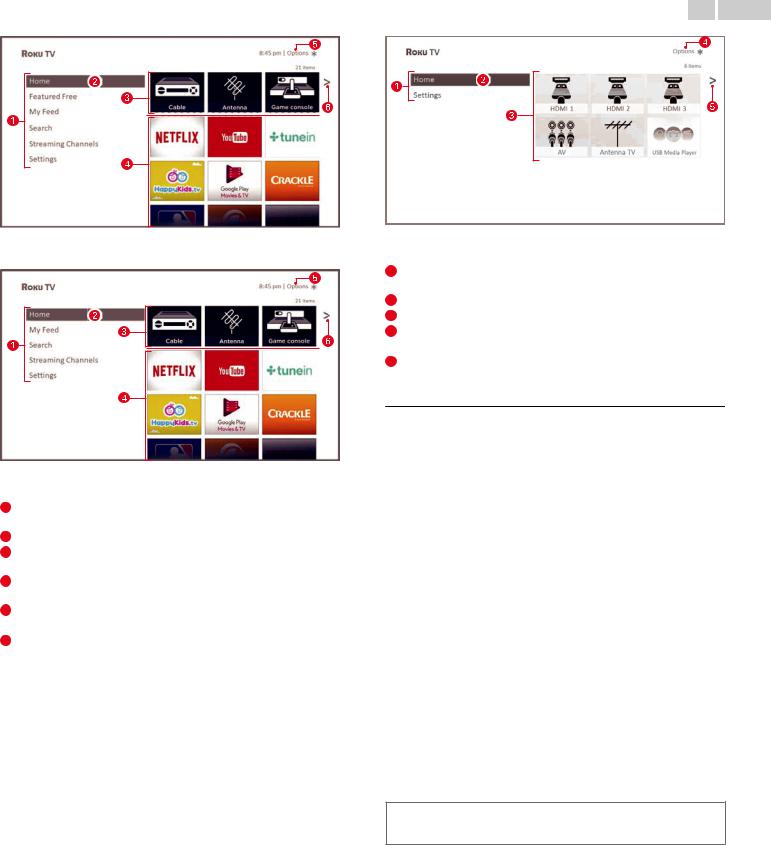
Typical connected Home screen, United States
Typical connected Home screen, Canada
1Home screen menu — shows options available to you when you are on the Home screen
2Highlighted option — press OK on the remote to select.
3TV input tiles — select an input to watch the connected device.
4Streaming channel and app tiles — select a tile to go to the indicated streaming channel or application.
5Options hint—press A on the remote for options when this symbol is present.
6Next screen hint—press the Right arrow on the remote to see the next screen.
20 .English
Typical non-connected Home screen
1Home screen menu—shows options available to you when you are on the Home screen.
2Highlighted option—press OK on the remote to select.
3TV input tiles—select an input to watch the connected device.
4Options hint—press A on the remote for options when this symbol is present.
5Next screen hint—press the Right arrow on the remote to see the next screen.
Personalize your Home screen
There are many things you can do to personalize your Home screen and make it just right for you and your family:
●Only in connected mode: Add streaming channels by using the Streaming Channels menu option to browse the Roku Channel Store.
●Only in connected mode: Change the screen theme by going to Settings > Themes to find and pick one to suit your mood.
●Only in connected mode on U.S. models: Hide Featured Free or Movie Store and TV Store as explained in Configuring parental controls L p. 48.
●Remove a tile by highlighting it and pressing A . Then highlight
Remove input or Remove channel and press OK.
●Move a tile by highlighting it and pressing A . Then highlight Move input or Move channel and press OK. Use the arrows to move the tile, and then press OK to lock it in its new location.
●Rename a TV input tile by highlighting it and pressing . Then highlight Rename input and press OK. Highlight a new name in the list, and then press OK to assign that name to the tile.
Rather than using the predefined names and icons, you can set a custom name and icon. To do so, scroll up or down to highlight Set custom name & icon, and then press OK. Follow the instructions on the screen to enter a name and select an icon for the input.
 Note(s)
Note(s)
●If you have renamed the inputs, you cannot use voice commands to switch inputs. Voice commands can only switch among inputs that have their original names, such as “AV,” and “HDMI 1.”
